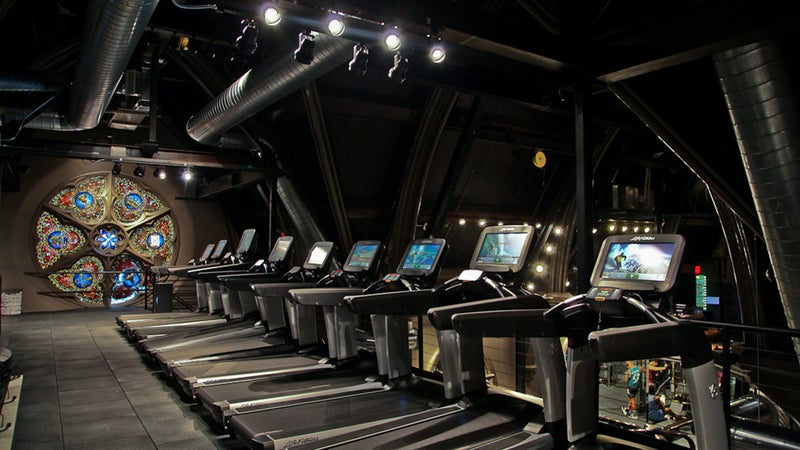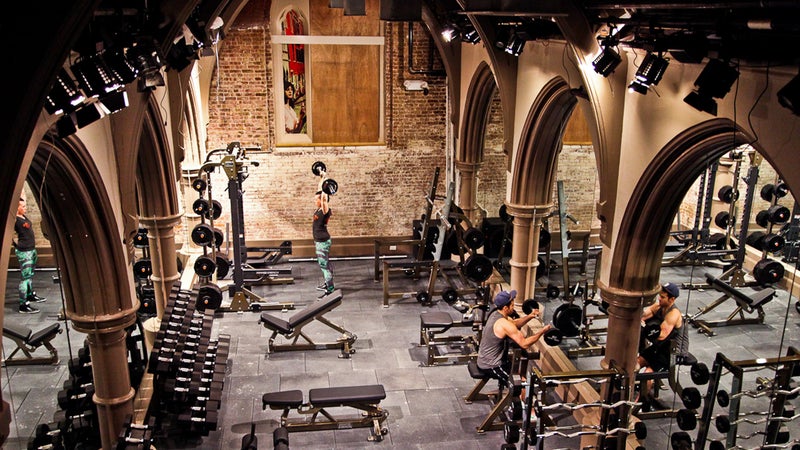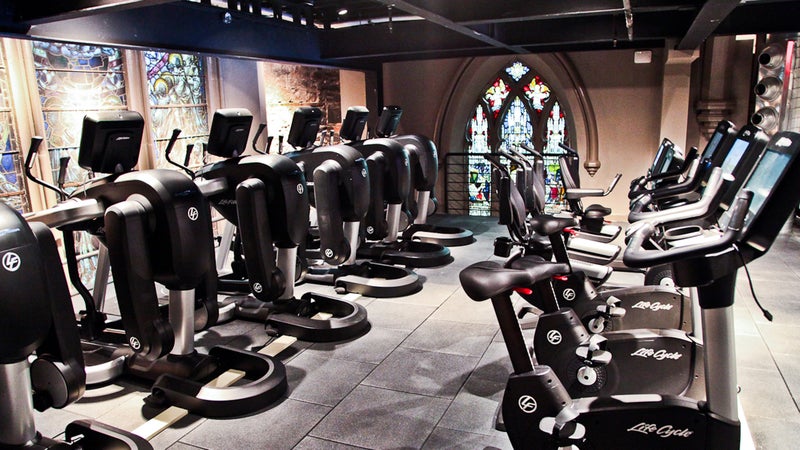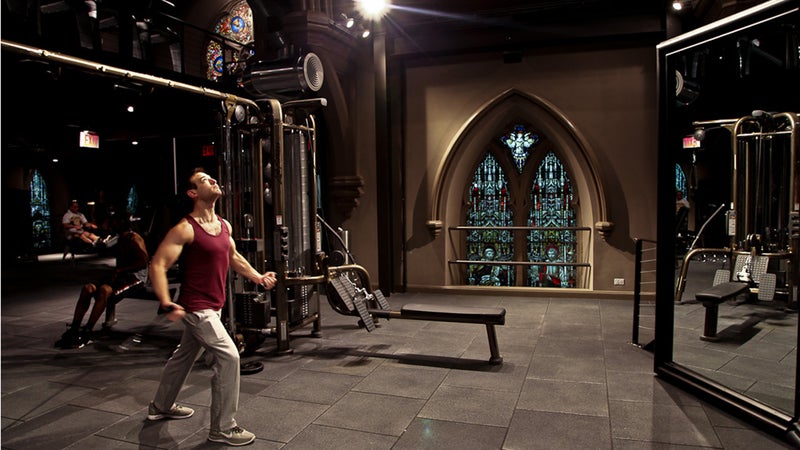Thou Shalt Work Out
American churches are building first-class gyms to get followers in shape and attract new members to the flock. Critics see lucrative businesses masked as ministries, but the programs are a spirited defense against our obesity epidemic.
New perk: Easily find new routes and hidden gems, upcoming running events, and more near you. Your weekly Local Running Newsletter has everything you need to lace up! .
The pilates class starts with a prayer. “I just pray, Father… to be strong and to be healthy, and just have the right focus… in Jesus’s name, amen.”
“Amen,” whisper 11 women over low-volume praise music and the hum of 9 a.m. traffic on Houston’s 10-to-610 interchange. Then instructor Debbie Brown, a spunky 56-year-old with a halo of bright red hair, gets to it. Flanked by two wooden crosses, her amplified voice sounding like a holy directive, she leads us through 45 minutes of stretches and strengthening exercises that’ll leave me face-flat on my Houston First Baptist Church–branded yoga mat.
This is my first time doing pilates. And my first workout in a church gym. I spend the top half of class worrying that my triathlon shorts are flashing too much thigh in a sea of calf-length black yoga pants. I spend the rest of the time wondering if I’ll be sent to hell because I thought it was funny when the band on the stereo sang “We press into you, God!” while we were all doing bridges.
I’m here because health-minded Christian pundits have hailed First Baptist as a shining example of what’s possible when religion and fitness unite. In late 2009, the church invested a quarter of a million dollars to renovate its existing 25,000-square-foot rec center, making it a viable alternative to the city’s upscale health clubs. Besides the Group X room—a full-size basketball court where 14 instructors teach pilates, TRX, high-intensity interval training, “Godspeed Spin,” and other classes throughout the week—the facility has two weight rooms with HFB-branded , a cardio room, an indoor track, sprawling locker rooms, a hydromassage bed, and, for good measure, six bowling lanes.

The walls throughout are adorned with snippets of health-related scripture: God gives power and strength to his people (Psalm 68:35, in the weight room); For in Him, we live and move and exist (Acts 17:28, in the Group X space); Strength and honor are her clothing (Proverbs 31:25, in the women's locker room). The place gives new meaning to the mantra “The gym is my church.”
“God wants us to be healthy and strong and to shine out his light for others to see,” Brown said as she took me on a tour before class. She’s First Baptist’s fitness-ministry associate, as well as its most popular pilates instructor. “We should be the fittest people on the planet!”
Athletics and the Christian faith have not always been mutually exclusive. In the mid-1880s, the Muscular Christianity movement arose in the UK, preaching that participation in sports could help develop morality and manly character. And since 1963, , funded by the famed evangelist, has espoused “whole-person education.” At its strictest, this meant that obese students could be suspended until they lost weight. That policy is no longer enforced, but in January the university announced that all freshmen in the class of 2019 would be required to wear Fitbits monitored by professors.
“God wants us to be healthy and strong and to shine out his light for others to see,” said Debbie Brown, First Baptist's most popular pilates instructor. “We should be the fittest people on the planet!”
Still, in the U.S. organized religion has largely focused on developing followers’ minds and spirits, leaving the body to team sports and athletic clubs. Now that’s changing. American churches are getting into the workout biz, and the effort is blowing up. The American Council on Exercise named faith-based fitness one of the top trends of 2016. There’s a magazine dedicated entirely to the cause () and a website that helps churches set up their own exercise ministries (). Last year, , a nonprofit best known for producing health-related listicles, ranked (number one: in Houston)—and that only covered congregations with more than 2,000 people attending weekly services.
Make no mistake: in an era of declining church membership, one of the main reasons faith-based gyms exist is to draw people to the gospel, whether they’re parishioners or not. “We want people to come,” says First Baptist fitness minister Dave Bundrick. It’s the exact opposite M.O. of big-box gyms that base their business models on people not showing up. Church fitness centers do charge fees, but they measure their success not in dollars but in what Bundrick calls ministry opportunities—interactions in which there’s a chance to “positively impact a person’s perception of our ministry, church, and ultimately, our God.”
Academics see another explanation for the trend. “It’s a response to the social and cultural problems of the age we’re in,” says Nick J. Watson, senior lecturer in sports, culture, and religion at in the UK, whose research focuses on the role of the church in public health. That’s a nice way of saying we’re fat. In August, he is gathering some of the world’s top Christian academics to meet with politicians, clergy, and athletes at the inaugural Global Congress on Sports and Christianity. The event’s goal is to encourage collaboration and improve public health through multidisciplinary research on effective interventions.
Watson, along with a growing number of other observers, is buoyed by the belief that church exercise programs could be a powerful weapon in America’s flailing battle against obesity. Ironically, the greatest challenge to the rising movement is coming from the mainstream fitness industry, which is doing everything it can to contain what it views as an existential threat.
It’s just before nine in the morning when the techno beats start pumping into a 147-seat conference room on the second floor of New Orleans’s Morial Convention Center. Attendees are gathered here on a drizzly Wednesday the week before Thanksgiving for the first-ever Faith and Fitness Conference, an eight-hour slate of presentations preceding the , one of the nation’s largest gym conventions. Tomorrow there will be meatheads everywhere. Today’s crowd looks more like a middle school PTA meeting.

Most attendees hail from the South: Texas, Louisiana, Arkansas, Georgia. The woman sitting next to me, Rhonda, teaches K–8 PE at a local Lutheran school. She’s also going to the larger expo, to look for fun kids’ sports equipment. Other participants work for church-based fitness ministries they hope to improve. A few would like to incorporate their faith into their own non-church-affiliated gyms. They’re all looking to conference organizer Brad Bloom, of Faith & Fitness magazine, and his panel of seven experts for enlightenment.
Bloom shuts off his EDM pump-up soundtrack and briefly takes the stage to introduce the first speaker, Rob Killen, the short and shredded owner of ChurchFitness.com. Killen kicks things off by reminding attendees about the value of a church gym. “We want church to be the go-to place seven days a week,” he says. “Not just Sundays.” Like many of the speakers that follow him, he discusses the religious duty Christians have to focus on exercise: “You could have a great heart, but your ability to serve is going to be impacted by your fitness level.”
Debra B. Morton, pastor of a Baptist church in New Orleans, explains what could be labeled the Jesus Is Jacked theory: “If we had to do what Jesus and his disciples did, walk miles and miles to minister, he would have very few followers today.” Another speaker argues that physical exercise mirrors what Jesus does for believers in the spiritual realm, breaking them down only to build them back stronger. And Laurie Graves, a personal trainer for NBC’s The Biggest Loser, laments the fact that pastors have long prioritized spiritual over physical health. “The message has been, ‘Don’t have affairs!’ ” she says. “But you can do food like nobody’s business.”
“Our vision for a healthy city can’t be achieved in isolation. Our faith-based organizations play a vital role in making this a reality.”
At other moments, discussions touch on the many deep-seated issues that church gyms bring up for ministry leaders. Is fitness vanity or a way to glorify God? Will it encourage evangelism or lustful thoughts? When a magazine runs a story on Joel Osteen, pastor of Houston’s Lakewood megachurch, and calls attention to his abs (as ), is that an opportunity to win over more converts or a triple whammy of lust, vanity, and pride? Even if a church’s leadership gets behind building a fitness center, these concerns don’t simply vanish. “We didn’t install any mirrors,” says Amy Johnson, a conference attendee who runs the fitness ministry at a Baptist church in Arkansas. Bloom, a slender, energetic guy in a mustard-colored polo, recalls the struggles that Faith Community Church in Indiana had when it wanted to put in an aquatic center. “They’re Baptists, and they really had to come to terms with the fact that, ‘Hey, we’re going to have girls running around our pool in bikinis! Can we deal with that?’ ” (Apparently, they could—the pool opened in 2007.)
And what about music? “You have to be super careful about what you listen to,” says presenter Michelle Spadafora, the toned, blond owner of Christian exercise-video conglomerate Faithful Workouts. “Music is alive and powerful, and it is a sword.” If you’re listening to, say, , your workout might cross the line from glorifying God into booty shaking. Baptists, meanwhile, have long had a complicated stance on dancing (remember Footloose?), making many trendy cardio classes a challenge. When I ask one leader of a Baptist church about this, he expresses relief that Zumba isn’t as popular as it once was.
For all these reasons, getting into the fitness business has been decidedly easier for non-institutional churches. Namely, megachurches—those supersized bastions of faith that have at times been accused of practicing a fluffy, self-indulgent brand of religion, among other things. They have been leading the charge in building new gyms and unabashedly telling members that their unhealthy bodies are hindering their full potential to serve God. Osteen’s Lakewood is the nation’s largest, with an estimated 43,500 people attending weekly services. In 2012, Osteen teamed up with his wife’s personal trainer, fitness guru Samir Becic, to create the church’s first Health Fitness Challenge. The eight-week program, launched that January, featured fitness and nutrition classes designed “to help families live a healthier, more active lifestyle,” according to its Facebook page. Parishioners resisted the health directive that first year, feeling a bit put-upon. “But after we had ten, twenty people see a tremendous difference” in their weight, Becic says, “they became ambassadors.” They started bringing their friends to Lakewood’s campus, the former home of the NBA’s Houston Rockets. The program has continued ever since, changing its name to Total Life Challenge, enrolling around 2,000 people this year, and earning Dr. Oz’s endorsement.

Similarly, California megachurch pastor Rick Warren has been crushing the diet market with his 2011 creation the Daniel Plan. Before expanding into waistlines, Warren shot to fame with his bestselling 2002 book and his heartfelt sermons at 36,000-member Saddleback Church in Lake Forest. The diet is named after the prophet Daniel, who rejected the rich food and wine of King Nebuchadnezzar in favor of veggies and water. Its widespread adoption has been hailed as a massive public-health victory. In the program’s first year, the church claimed that 15,000 members lost a collective 250,000 pounds. The “secret sauce,” Warren told the Los Angeles Times, “is faith, friends, and focus.” He preaches that mind, body, and spirit must be in harmony for people to be good stewards of the body God has given them. (Incidentally, Zumba is one of Saddleback’s most popular fitness classes.)
Social scientists look at the impact that megachurches like Lakewood and Saddleback are having and see huge opportunities for faith-based health interventions. “How sport and Christianity relate with regard to health, fitness, and wellness is an emerging area in academia,” says Watson, a fit 44-year-old who loves indoor bouldering and became a Christian at age 30. He and others have published numerous papers on the topic, with titles like “Health Promotion in Megachurches: An Untapped Resource with Megareach?”
According to the Pew Research Center, more than 40 percent of Americans still attend church every week. That number is thought to be higher in the South, where obesity rates are the worst. As was repeatedly pointed out during the Faith and Fitness Conference, a dozen cities in Louisiana consistently rank among the nation’s fattest, with Opelousas residents tipping the scales at 42.3 percent obese. “Food is ingrained in the culture here,” said Nettye Johnson, a conference attendee determined to help her fellow parishioners at New Hope Baptist Church in Baton Rouge stay healthy. When you take away local favorites like beignets and po’boys, she said, “it’s like you take away who I am.”
In one recent battle in Kansas, when lawmakers failed to knock down the YMCA’s tax status, they took another tack, attempting to win tax exemption for all health clubs in the state. The proposal didn’t pass.
Watson and other researchers make a compelling argument for the potential of churches to change that attitude, and now public officials are beginning to support their efforts. Last year the mayor of Trenton, New Jersey (obesity rate, 39 percent; religiously affiliated, 52.6 percent), awarded seven local churches grants totaling $56,445 to help them promote exercise and healthy eating as part of a Faith in Prevention initiative by the state’s Department of Health. The department has since pledged to give qualified faith-based organizations up to $900,000 to implement community health programs.
“Our vision for a healthy city can’t be achieved in isolation,” mayor Eric Jackson said at a press conference where he announced the grants. “Our faith-based organizations play a vital role in making this a reality.”
Creating a church fitness center that can compete with a regular gym is expensive and time-consuming. “It’s a business,” Debbie Brown told me during my visit to Houston’s First Baptist. Just like any other gym owners, the church’s leadership has to keep tabs on employees, day-to-day details like membership-card scanning, and marketing strategies to recruit, engage, and retain new participants. First Baptist’s Fitness and Recreation Ministry is a $1-million-a-year enterprise that generates about three-quarters of its income on its own, partly through the $25 per month it charges roughly 1,200 members. (The gym also offers scholarships.) The other $250,000 comes from church revenues gathered through offerings at Sunday services. The gym isn’t profitable as a stand-alone business, but the cost of running it is still less than 1 percent of the church’s $31 million annual operating budget.
In the secular business world, First Baptist’s fitness center is known as a loss leader. Bundrick points to the 43 percent of its gym members who aren’t affiliated with the church; by his estimate, visits to their workout facilities generate more than 9,000 ministry opportunities per month. “It helps our church be relevant in a culture that’s very health-minded,” he says, “better than any other aspect of the church.”
Maybe so, but many lawmakers and leaders in the fitness industry argue that religiously affiliated fitness centers are using their tax-exempt status to offer rock-bottom membership fees that help them siphon off customers from for-profit gyms. It’s unfair competition, critics complain, and it’s time to level the playing field. In 2004, Nashville’s Christ Church opened a 104,000-square-foot family life center and began charging a $100 annual fee—the amount many for-profit gyms charge per month. Half of the 800 people who signed up weren’t part of the church. The State Board of Equalization filed a lawsuit, claiming it was a commercial enterprise. After an extended court battle, Christ Church agreed to pay a 50 percent property-tax rate on the building.
“I’m not anti-government—there has to be a tax base,” says Dan Scott, pastor of Christ Church, which sees about 4,500 attendees at weekly services. He makes it clear that he harbors no resentment toward the state and recognizes that some megachurches do take unethical advantage of their tax status. “In the end,” Scott says, referring to the settlement, “the city and state didn’t get why a church needs to have a gym.”
It wasn’t an unusual outcome. Church fitness centers have had a rough time in court recently. In 2014, an Ohio appeals court denied tax exemption for the gym at Vineyard Community Church, near Cincinnati, on the grounds that it wasn’t warranted because the facility wasn’t primarily used for worship. The same thing happened in 2011 to Northmoreland Baptist Church in Pennsylvania, but the decision was overturned the following year. The appeals judge ruled that the church’s gym wasn’t in direct competition with for-profit businesses, in part because its basketball court doesn’t have wooden floors or locker rooms.

For Christ Church, the 50 percent property tax made it financially impossible to continue operating its own gym. But the facility didn’t close. “The YMCA took it over,” says Scott. “They’re not questioned.”
Indeed, the YMCA retains an unofficial, grandfathered status as a nonprofit fitness and community center, despite functioning very much like a standard gym in most places. Revenues, including those from membership fees, are typically not taxed, while many Y’s also receive millions of dollars annually in government subsidies to build and maintain facilities. Since as early as 1950, Y’s across the country have been repeatedly challenged over their tax-exempt status but have almost always prevailed in court. In one recent battle in Kansas, when lawmakers failed to knock down the YMCA’s tax status, they took another tack, attempting to win tax exemption for all health clubs in the state. The proposal didn’t pass.
But the battle in Kansas and across the U.S. is not over. Y’s continue to face an offensive from the , a powerful industry group with 10,000 member gyms in 75 countries. For more than a decade, the group has mounted an aggressive effort to have YMCAs taxed like any other health club. “Selling adult fitness services is a business,” says IHRSA spokeswoman Meredith Poppler. “We support identical tax treatment for identical business activities.”
In 2015, Kansas lawmakers passed House Bill 2109, requiring all YMCAs in the state to pay sales tax starting in 2020. The IHRSA would like to make that happen nationwide, and if the effort succeeds, it could abruptly end Christianity’s fitness awakening. In the meantime, whether megachurches are building gyms to attract parishioners or dollars, they are getting a whole lot of people to start exercising. And if the pilates class at Houston’s First Baptist is any indication, they’re going to get righteously fit.
As we wind down from our 45-minute session, we sit cross-legged, eyes closed, in the glow of two tower lamps that light up the wooden crosses at Debbie’s sides. She whispers a final prayer into her mic before sending us back into the world with sore thighs and a sense of inner peace: “We thank you, God, for giving us this time to come meet with you, to enjoy one another, and to be strong, and to be healthy. Amen.”


